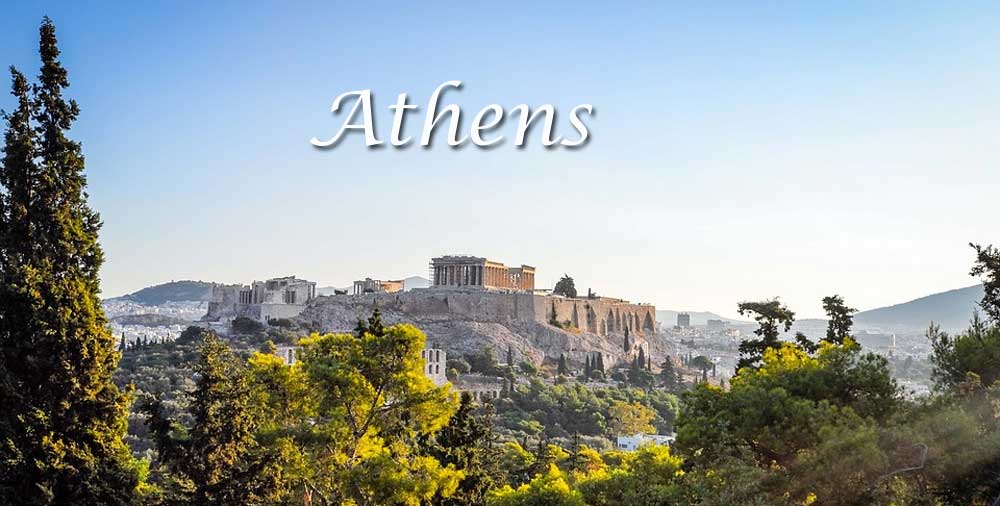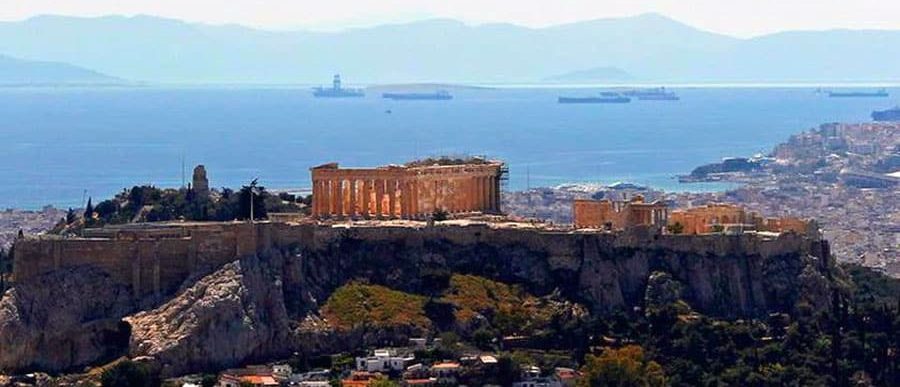Guide to the city of Athens Greece
Athens, the capital of Greece has a strong personality that combines modern and ancient Greece in a unique and unrepeatable mix. Glorious and timeless, Athens – the cradle of Western civilization – beckons travellers from every corner of the globe with its rich historical legacy and vibrant culture.
This dazzling city, where ancient ruins meet a thriving metropolis, promises a travel experience like no other. From the iconic Acropolis that majestically overlooks the city to the bustling tavernas offering mouth-watering Greek delicacies, Athens weaves a captivating tapestry of history, cuisine, art, and nightlife that is certain to ensnare the senses and evoke awe and admiration.
The iconic temples of the Acropolis, first of all the Parthenon, considered the highest expression of classical Greek architecture, the mythical ancient stadium where the modern Olympic Games began, the agora where Socrates taught philosophy and some of the most important museums of ancient art in the world are the wonders that everyone expects to find in Athens.
Although proud of its glorious past, the Greek capital looks ahead and pulsates with energy. It is a modern city, where you can visit contemporary art galleries, photograph creative street art
Athens belongs to the top travel destinations and covers all the basic conditions to be a pole of attraction for tourists from all over the world in recent years. Sights, hidden secrets, alternative options and activities to get to know Athens from every side
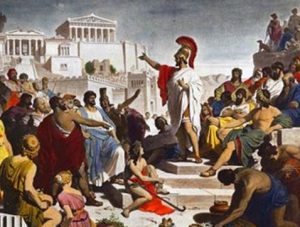
It is the history of its culture. Athens is the inventor of democracy, political freedom, rhetoric, tragedy and comedy, the classical art that combines measure with natural truth and the end of dialectical philosophy.
These conquests were regarded as a valuable ancestral heritage by the cities that succeeded Athens in the hegemony of the world, such as Pella, Alexandria and Rome.
Throughout its centuries-long history, Athens received influences but also transmitted knowledge and culture. Twice in the history of modern Europe, in the 10th and 18th centuries, nostalgia for Athenian rhythms in architecture and the visual arts had contributed to the classical and neoclassical renaissance.
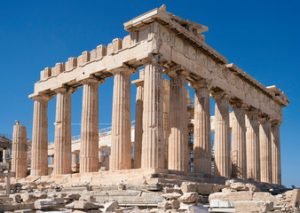
Athens accepted refugees from Asia Minor, Egypt and the Balkans. Cities like Rome, Florence, Paris, London, Munich, Berlin, Leningrad, Washington, Philadelphia are adorned with monumental buildings whose architectural rhythms have their origins in Athens Greece.
And all this diverse socially, economically, culturally, and even linguistically, fermented together and formed the material of the modern capital.
Mythology
According to legend, when the city of Athens was being established, Athena and Poseidon both vied for the honour of becoming its patron deity. They presented their gifts to the people of Athens, and Poseidon struck the ground with his trident, creating a spring of saltwater. Athena, on the other hand, offered the olive tree, which was seen as a symbol of peace, prosperity, and civilization. The Athenians chose Athena’s gift, and she became the city’s patron god.
Cecrops
The first king of Athens was Cecrops. Cecrops was a legendary figure who is believed to have ruled over Athens and played a crucial role in its early history. He is often depicted as a half-human, half-serpent being.
Cecrops is credited with several important contributions to the city of Athens. He is said to have introduced laws, established a system of government, and introduced marriage. According to legend, he also divided the Athenians into four tribes, named after his sons—Autochthon, Aerope, Pandion, and Neleus—and appointed local chieftains to lead each tribe.
Theseus
After his victory over the Minotaur, Theseus returned to Athens, where he played a pivotal role in uniting the various tribes of Attica (the region around Athens) and establishing Athens as a political and cultural center. Theseus is credited with creating a more unified government system, bringing the tribes under a single rule, and instituting a fairer justice system.
According to some versions of the myth, Theseus became the king of Athens and ruled for many years. He is often portrayed as a wise and just ruler who contributed to the growth and prosperity of the city.
History
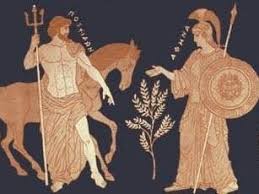
More recently this has been supplemented by the discoveries of archaeology, which reveal the details of daily life in Athens, as well as the accomplishments of Athenian architects and artists.
The techniques of literary criticism, anthropology, and sociology have also helped form a more balanced and complete picture of Athenian civilization. In the 5th century BC. the city of Athens is growing rapidly. The city of the Goddess Athena, under the leadership of the famous Rhetor Pericles, will be able to experience the greatest glory that a city would ever know! Pericles will be the one who will highlight it and through his policy Athens will enter the so-called “Golden Age”.
The Parliament, Arios Pagos (highest court), Theater, arts, concepts that will not only affect the whole of Greece but will shape the whole world in what it is today.
The most important of all, of course, and what shows that the culture of Athens has reached its zenith, is the birth of Democracy! Huge works will be created during that period which are expected to radically change the image of the city and the history not only of Greece but of the whole world.
Many leading Greeks will live in the same period, Sophocles (496 – 406 BC), , Euripides (480 – 406 BC), Thucydides (460 – 395 BC). X.), the leading Greek historian, Aristophanes (450 – 380 BC), perhaps the greatest comedian poet of Ancient Athens and many many others.
What to see and do in Athens
Unravelling History
The Acropolis
No trip to Athens would be complete without a visit to the Acropolis, the ancient citadel located on a rocky outcrop above the city. Here, you will find architectural wonders such as the Parthenon, the Erechtheion, the Propylaea, and the Temple of Athena Nike. These temples, dedicated to various deities of the Greek pantheon, are testament to the architectural prowess of ancient Athenians and their deep reverence for the gods.
The Ancient Agora
After exploring the Acropolis, journey down to the Ancient Agora, the heart of public life in Athens during ancient times. Once a bustling marketplace, this historic site now showcases ruins of various political and public buildings, including the well-preserved Temple of Hephaestus and the Stoa of Attalos, which houses the Museum of the Ancient Agora.
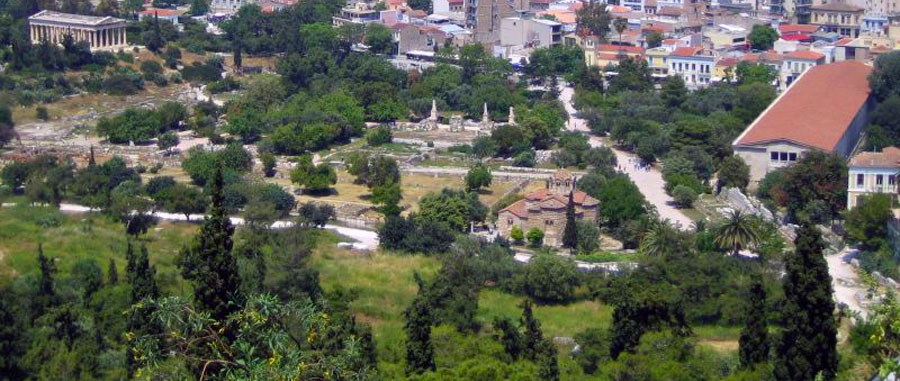
The National Archaeological Museum
Enrich your understanding of ancient Greece at the National Archaeological Museum, home to one of the world’s most impressive collections of Greek artifacts. Highlights include the Mask of Agamemnon, the Antikythera Mechanism, and the stunning frescoes from Santorini.
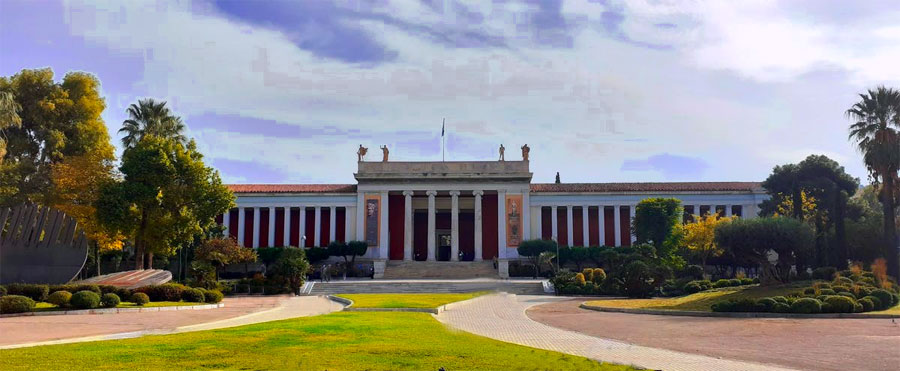
Places to visit in Athens
There are many places to visit in Athens that sometimes you can spend the whole day just strolling around. A place like that, is Monastiraki and its famous flea market with all kind of old and new stuff, a place that first was used by the rag and bone men of Athens as their main market place. Just across Ermou street from Monastiraki is the area of Psiri with numerous restaurants, bars , cafes and taverns with Greek live music both Monastiraki and Psiri is something like the Camden market in London. But do not forget the beaches of Athens.
From the Lycabettus hill you can have an amazing panoramic view of Athens. The coastal road from Faliro to Glyfada, Vouliagmeni and further until Sounion is full of sandy beaches, yacht marinas, hotels, sport clubs, a worth seeing Riviera of Athens. From the port of Athens, Piraeus you can visit the beautiful Greek islands of the Aegean world famous for their nature, history and tourist attractions like Crete, Rhodes, Kos, Santorini, Mykonos and many others.
The brand new pedestrian streets around the Acropolis, the numerous museums, highlighting the New Acropolis Museum,the art exhibitions, the cultural complexes and the festivals, the lively gastronomic landscape, the lively downtown neighborhoods, make the center of Athens the strongest attraction for visitors to the city.
Increasingly hip in recent years the area of Gazi has become an all year round hot spot. Especially in the summer, the main road and the square of the metro station resemble an island. Restaurants and bars set tables outside, everyone is on the street, in a perpetual motion.
Metaxourgio, which follows closely with more alternative and art profiles, the timeless village of art and entertainment in Psyrri area in Monastiraki, which along with the night spots now gives reasons for all-day walks.Athens with its unique cultural potentials and its constantly evolving accommodation, food and night landscape has become a popular year round destination for both tourists and Greeks from the provinces. Piraeus the port of Athens, beyond the main port of the country has hidden secrets both in terms of eateries, cafes, attractions and entertainment.
Athens neighborhoods
Athens is not only the center, it is every area in the capital with which its inhabitants have connected their memories and have left there a small piece of their heart. From Pagrati and Kato Patisia, to Paleo Faliro and Peristeri are some of the most beloved neighborhoods in the city of Athens.
Nea Smyrni has simple, green areas, parks where you can enjoy hours, a square – a trademark, and it is a breath away from the sea, but also quite close to the city center. The Guardian was not wrong to rank it among the top neighborhoods in Europe.
Holargos is green neighborhood that combines nature and an urban element in its own unique way, Cholargos has the countryside, it has peace, but also a buzz, while its proximity to Hymettos makes it a very… nature-loving choice.
Chalandri where you enjoy walking, squares that are buzzing with life morning and night, dozens of options for food, drink and spree, but also plenty of greenery in streams and groves, a feast for the eyes.
Kypseli is included in the 50 coolest neighborhoods on the planet and is experiencing a second youth, with its renewed municipal Agora, the multicultural pedestrian street of Fokionos Negri and the special bars and eateries that line its squares.
.
Glyfada and Voula, the Athenian Riviera as they call it, is defined by these two cosmopolitan coastal areas that offer both mountain and sea, dozens of hip shops, beautiful squares and marinas.
Pagrati and Metz are central but also on the outskirts, it has some of the best bars in the city and plenty of squares full of people. It is always alive, always charming and now one of the sought-after districts of Athens, in the company of its “little brother” Mets.
Kifissia is the queen of the Northern Suburbs. Green, with beautiful parks, centuries-old plane trees, Cyrillic places for coffee and food, but also traditional taverns with decades of history, and an interesting market.
Petralona, the old Athens at its best, neighborhoods from those that are missing, cafes, summer cinemas, squares full of life and the feeling that you are in the setting of an old Greek movie.
Piraeus is whole city next to Athens, so close and yet so far. Piraeus is evolving year by year, while it has some of the most beautiful neighborhoods we have seen – such as Kastella, for example, but also more nostalgic ones, such as Kaminia and Drapetsona.
Old and New Faliro where you walk next to the sea, under the palm trees that give its porch the humorous Falifornia. Old (and New) Faliro has rides, it has Marinas, it has the SNFCC, it has everything.
Koukaki is neighborhood with everything, close but also far from the Acropolis, Koukaki maintains the glamor of old Athens and is a square for every moment of the day. For drinks with friends, for walks, for everything.
Bohemian and eclectic, Exarchia is the ultimate youth square. They have a strong street art but also an artistic element in general and are buzzing with life thanks to the dozens of record stores, alternative bookstores, cocktail bars with selected music and the bars where the domestic music scene finds a place to express itself.
Nightlife
Athens has a plentiful supply of music bars, rock and jazz venues and discos to choose from. Head for one of the many rembetika clubs to hear this traditional Greek music (a kind of Greek-style American blues with the added twist of a bouzouki!).
One of the best known clubs is Rembetiki Stoa Athanaton in Sofokleous near the meat market a little way to the north of the Monastiraki flea market.
This is the place to go for quality rembetika which purists will enjoy more than the tourist orientated Greek music and folk dancing to be found in the bars and restaurants of the Plaka district.
Entertainment
As the sun dips below the horizon, Athens transforms into a city of lights and lively energy. The nightlife in Athens is as diverse as it is vibrant, with options ranging from sophisticated wine bars and jazz lounges to pulsating nightclubs playing a mix of international and Greek music. For a more local experience, try catching a Rebetika performance, often called the Greek blues.
Summer in Athens could be summed up in a few words, then these would be concerts, fountains, squares, dancing, summers, terraces and countless walks in every part of it. Wine bars, which is a phenomenon with huge and very high-quality growth in Athens. Fun parks and night clubs
Eating out in Athens
There are many eateries in Athens that you always turn to when you want to eat deliciously, simply and economically. Taverns, cafes and family kitchens that look like an extension of a home kitchen, serving seasonal foods, pulses and oils, fish in the pan, appetizers and unique specialties and when the time for the bill comes, you know that you won’t pay much.
The quality-price ratio plays an important role, the way some restaurants approach their cuisine, either by having a fixed small menu or by choosing economical raw materials with flair and imagination, contributes to keeping the costs low and not discounting the taste.
Take your friends, don’t eat even a couple of days before and visit the biggest and most delicious culinary event in Greece at Zappeion. 10 of the best restaurants in the country, top chefs, iconic dishes and a full program of music and entertainment await you!
Summer cinemas
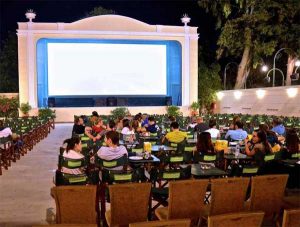
Most of them lined up sometimes between apartment buildings and sometimes on cool rooftops.
An image that puts you in a romantic mood and sometimes you feel that it transports you to another era, against the background of French film noirs or the latest releases.
Summer cinemas make Athenian nights special and carefree. There are many options, some all time classics loved by the cinephile public, while some “hidden gems” are waiting for you to discover them in Athens
Athens day trips
In the summer, visitors who stay more than 3 days, often plan a beach or even a visit to the Argosaronic islands as part of their stay. The summer cinema also seems unique to visitors. They like it, as it is something they usually don’t have in their country, at least not as organized as in Greece.
Athens has a great appeal for city breakers, both in sightseeing contexts such as the Grand Promenade walk in the archaeological park route from Monastiraki to Dionysiou Areopagitou and Columns of Olympian Zeus, as well as simply getting to know the neighborhoods of the city. Now many visitors choose more alternative ways of touring, such as the guided tour with scooters or bicycles. In general, fitness and well being options are constantly gaining ground
National parks, ancient monuments and a vast coastline that lacks nothing:, the outskirts of Athens hide many interesting surprises for excursions of historical, culinary and nature-loving interest, usually only an hour’s radius from the city center.
Every resident and visitor owes themselves a visit to the Temple of Poseidon in Sounio (if only for its prime position on the Saronic Gulf and the beautiful coastal route that leads there).
On the southeastern coast, a few kilometers from Sounio, Lavrio still emits the “smell” of its mining past (from the impressive industrial facilities of the French Company of the 19th-20th centuries in the picturesque town to the ancient “laundries” on its slopes Souni National Park).
The sanctuary of Artemis in Vravrona, the Amphiaraion of Oropos, Ramnounda and the scattered archaeological sites in Marathon are an attraction for archeology lovers and for those who want to add another dimension to day trips for diving on the east coast of Athens.
The area of Marathon, in fact, offers in itself a complete excursion package that combines nature with the coastal pine forest and the wetland of the Schinias Marathon National Park, as well as fun and sports at summer beach bars of the area.
The paths and monasteries of mount Hymettus as well as the fir-covered slopes of Parnitha, offer lightning excursions and leisurely hikes, while at the foot of Parnitha the Tatoi Estate is a particularly popular family destination on weekends.
The west of Attica is characterized by intense industrialization. However, Eleusis, with its important ancient heritage, is firmly on the agenda in late summer thanks to Aeschylia, the local festival, while the beaches on the west coast boast perhaps the most idyllic coastline in Attica.
The country taverns of the prefecture also give the Athenians reasons to go on a culinary trip, for Greek style grilled taverns in Hasia, Kalyvia, Stamata and Vari and for seafood in Rafina, Nae Makri and in the area of Sounion. Wine lovers note that in the Mesogeia area, the center of Attica’s vineyard, there are wineries to visit.
Historical centre of Athens
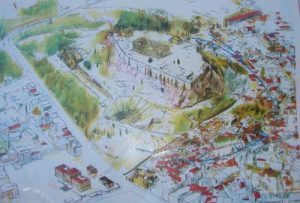
In the Historical center of Athens coexist and intertwine, for more than 170 years, the public administration and the emblematic buildings-symbols of the Greek state, the New and Old Parliament, the Academy at the University, City Hall, etc., the central market of the city, the crafts that traditionally concentrated in the northern part of Piraeus and in the area of Psirri, residence, entertainment, culture and, of course, real estate speculation.
These components are constantly shifting, changing, evolving and re-defining, forming overlapping layers in a constantly active urban geography. Important buildings appear and disappear, leaving their traces in the urban fabric and in place names such as Varvakeio Lyceum, Bukuras Theater, Chiler’s Municipal Theater, the National Mint, etc., development centers emerge, recede and return.
Athenas Street, although it was designed as an axis of symmetry, from the beginning, played the role of an internal border that intersects this dynamic whole into two distinct and socially asymmetric subsets, in the context of the wider, real and mainly symbolic, spatial and social division of the East/West Basin -corresponding to the separation of dominant social strata, but also administration and production.
The dynamic of the changes in land uses, which starts already from the phase of the successive revisions of the first plans of Athens, with the location of the Palaces as a focal point, highlights the Historical center as a central stake in the social struggle for the control of the City Center, which in any case has always been par excellence a field of manifestation of social and class confrontations
The atmospheric pedestrian streets around the Acropolis, the big exhibitions, the rich potential of the museums, highlighting the New Acropolis Museum, the cultural complexes and the festivals, the lively, even in times of crisis, gastronomic landscape, the lively downtown neighborhoods, make the center of Athens the strongest attraction for visitors to the city. Increasingly hip in recent years, Gazi has become an all year round hot spot. Especially in summer, the main road and the square of the metro station resemble an island.
Restaurants and bars set tables outside, everyone is on the street, in a perpetual motion. Metaxourgio, which follows closely with more alternative and art profiles, the timeless “village of art and entertainment” in Psyrri, which along with the night spots now gives reasons for all-day walks, the idiosyncratic and forever young Exarchia, the Syggrou Avenue with the dynamic cultural package of the House of Letters and Arts, the museums and cultural centers of Vasilissis Sofias Avenue, and the ever-changing Piraeus Avenue are some of the neighborhoods of the wider city center that keep our interest constant.
Walk around Athens
On a sunny day walk up the sacred rock of Acropolis and visit Parthenon the world famous landmark of Athens. Τhe Acropolis of Athens is the main attraction of the capital of Greece. On the rock that dominates the centre of the capital, the ancient Greek culture was expressed in the most ideal way and some of its top monuments were built, such as the Parthenon, the Propylaea, the temple of Nike, the Erechtheion and others. Visit Plaka the oldest and most attractive neighbourhood of the Greek Capital, stroll around the narrow streets and enjoy the neoclassical mansions, climb up the steps to Anafiotica and explore a hidden small village in the heart of Athens!! Plaka used to be called by the Greeks the neighbourhood of the gods, today Plaka is one of the main attractions for the tourists, restaurants, cafes, souvenir shops all can be find here. Anafiotica is a must see area just over Plaka and under Acropolis to the east .
Anafiotika is like a small island within Athens, builders from the small island of Anafi build their traditional white washed houses in the tiny winding streets and steps of this area when they were building the royal Palace.
Today the Palace is the Greek Parliament and rights on its front is the Parliament square or Plateia Syntagmatos in Greek , the most central place of Athens.
The Panathenaic stadium where the first Olympic games took place located a few minutes walk through the National Gardens or through Zapeion. Athens has many neoclassical buildings like the Athens Academy, the National Library, The Historical museum, the Archaeological museum and many others mainly at the streets of Panepistimiou, Stadiou, Athinas, Patission (28 October street), around Omonia square and in the area of Plaka where located the first university of Athens and many neoclassical houses
Omonia Square has been characterised as the “navel of Athens” as it is a key point of the city. This is where the main streets of Athens start, such as Panepistimiou, Stadiou, Athinas, Pireos, Agiou Konstantinou and Third of Septemvriou street, which is why it is a place where everyone passes every day. A few meters from the square located the City Hall, in Kotzia Square and immediately after the Varvakeios Agora, the busiest in the city. In the area of Omonia located also the National Theater, on Agiou Konstantinou Street.
The pedestrianised Dionysiou Areopagitou street is one of the most beautiful walking routes in the city, overlooking the Parthenon on one side and the magnificent mansions on the other. Here is the New Museum of the Acropolis, next to the metro station Acropolis (which is also interesting, as it has on all levels casts from the sculptural decoration of the Parthenon).
With the unification of the archaeological sites, the shaped road is connecting the archaeological sites of the Olympion, the Theater of Dionysus, the Theater of Herodes Atticus, the Acropolis and the Areios Pagos.
Athens Historical Center
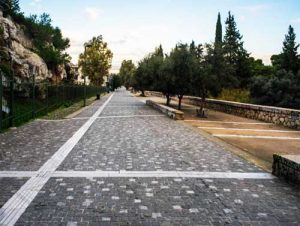
Increasingly hip in recent years, Gazi has now evolved into an all year round hot spot. Especially in the summer, the main street and the square of the metro station resemble an island. Restaurants and bars put tables outside, the whole world is on the street, in a constant movement. Metaxourgeio, which follows closely with a more alternative and art profile.
The timeless art and entertainment village in Psirri, which, alongside the night spots, now also provides occasions for all-day walks, the idiosyncratic and forever young Exarchia, the Syngrou Avenue with the dynamic cultural package of the House of Letters and Arts, the museums and cultural centers of Queen Sofias Avenue, and the ever-changing Piraeus Avenue are some of the neighborhoods of the wider city center that keep our interest undiminished with constant transformations
North Athens
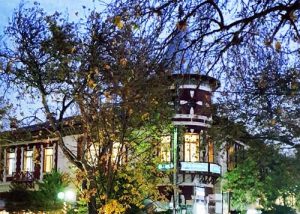
Characteristic landmarks are the geographical boundaries of the region: Psychiko (where many diplomatic missions of foreign countries are based) and Kifissia.
This former country suburb with its old mansions, in addition to being a privileged place of residence, is a destination for designer’s shopping, for gastronomic outings and for family educational trips to the environment-dedicated Goulandris Museum of Natural History – Gaia Center.
For your night routes, Nea Erythraia is the hot spot of the northern suburbs, Chalandri has become the joy of clubbing, while Psychiko and Melissia have recently been experiencing great mobility.
West Athens
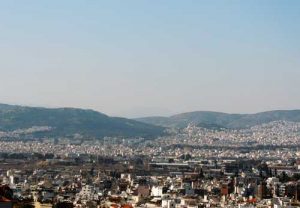
The metro lines that connect Aegaleo and Peristeri in just a few minutes with the center of Athens, also introduced to foreigners the clothing and footwear stock centers of Peristeri and of course the cafe-bars of the mainstream square that unfolds in Burnazi, while inside in the general atmosphere of the development of bars, Aimiliou Veaki Street has recently seen a spectacular rise.
Among the hubs that entered the map so that we now pull the handbrake for shopping is of course the axis of Kifissos with large shopping centers.
Athens riviera
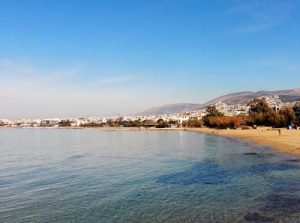
The first stop on the beach going down from the center, Faliro with the unused (currently) Olympic sea front and centerpiece of the renovated Marina of Flisvos, is suitable for the sun for cyclists and summer cinema and awaits the implementation of the major regeneration projects of theFaliron bay, with the project for the New Lyric Theater and the National Library, by Renzo Piano, on the site of the old hippodrome, already under way.
In all weathers, Glyfada is a classic destination in the area for shopping in its malls as well as for drinks or food, while Vouliagmeni with its luxury resorts is identified with the upper class version of the Athens Riviera.
Frequently asked questions
What is the Altitude of Athens?
Athens slopes down to sea level, so the altitude in many spots is approximately zero. The altitude of the Acropolis is about 490 feet or approximately 150 meters above sea level. However, Athens is surrounded by mountains and also has a number of hills, including the rock of the Acropolis, Lycabettus Hill, and Philopappus Hill. The Acropolis is not perfectly even, so different measurements will vary.
What Are the GPS Coordinates for the Parthenon ?
In the old days, this question would be “what are the latitude and longitude of the Parthenon”? In either case, here is one answer: 37°58′27″N, 23°43′39″E.
How long will a flight take to Athens?
Obviously, this depends on where you start and if your route requires connections, which generally add a minimum of two to three hours to the flight time, including both the flight time “wasted” during the descent and take-offs and the actual time dashing through the terminal.
What time is it in Athens ?
The time difference depends on your location, and can also vary because of the start and end of Daylight Savings Time as different nations start and end DST on different dates. The link to the World Clock provided helps you calculate the difference between your location and Athens, Greece. All of Greece is in the same time zone, the Eastern European Zone or EET, so you don’t have to worry about multiple time zones affecting the difference.
Is Athens Safe?
Athens is widely considered to be among the safest of world capitals. That being said, it never hurts to exercise reasonable precautions especially if you are wandering through the city on foot late at night. There are some instances of purse snatchings and pickpockets; the purse thefts are usually when someone is sitting on a bench or at a cafe with a bag slung over a chair or placed down at the side.
How Big is Athens?
Athens is a huge, sprawling city with many interconnecting streets. Its area is about 165 square miles or 428 square kilometers.
What’s the Population of Athens?
About 5 million people live in the “greater Athens area”, which contains most of the visible sprawl from the heart of the city to the outskirts. Increasing problems with undocumented immigrants make the number a particularly loose estimate.
Well-to-do Athenians often have second or old “family” homes elsewhere in Greece and may or may not be counted in census figures for Athens itself. Greece’s overall population is estimated to be about 11 million, and so almost half the population of Greece lives in the Athens area. Recent census figures are still pending.
Museums
A city with a history lost over the centuries, Athens preserves modern and archaeological treasures of global scope in museums and cultural sites that characterize its special identity.
Almost all of them you’ve at least heard of, and most of them you’ve probably visited at some point as a visitor to Athens.
The Acropolis Museum remains a top choice . But the museum of Cycladic Art is also quite interesting, as is the National Archaeological Museum. Many visitors are surprised by the number, quality and low cost of concerts and festivals held in Athens and choose them.
Eating out
The typical dishes of Athens are not as spicy as it might be thought and the spices normally used are not so different from those found on our tables every day. A detail that will surely push you to savor Athenian cuisine is the use of olive oil, which offers dishes a particularly strong flavor, helping to enrich them with taste.
Among the typical Athenian dishes, Keftedes stands out, delicious fried meatballs that are prepared in different places in the area (some based on fish, others based on tomatoes, chickpeas or cheese). Still, particularly palatable is the Melitzanosalata, which is an eggplant salad usually accompanied by bread.
The majority of tourists chooses restaurants of traditional Greek cuisine, while in almost all agendas there is at least one “souvlaki” option.Those who belong to the premium audience often also choose the recommended molecular cuisine restaurant or other restaurants that express modern trends.
How to get to Athens
By Air
The plane is the quickest, cheapest, most used and most logical way to get to Athens. The airport, Eleftherios Venizelos, located about 33 kilometers from the center of the Greek capital. You can get to Athens centre from the airport, by taxi, the Metro or the express buses.
By sea
Unless you are taking a cruise in the area, the best options to reach Athens by sea are to depart from the Italian ports of Ancona, Venice, Bari or Brindisi. The port of arrival is normally the port of Patras in Peloponnese,200 kilometers west of Athens. You can get to athens from Patras by bus or train.
By train
It is mostly recomended only for younger and adventurous travelers since it can take over 48 hours from Paris. Athens is connected by train to the north and western Europe through the railways that passes through the Balkans, in fact it still exists the old Orient express route from Paris (Gare de Lyon). From Germany the train runs through Austria from Munich and enetrs the Balkans from Slovenia The railway tracks run through the eastern part of Greece.
Greece is connected by train to Turkey, Bulgaria and Albania.
Moving around Athens
By car or bike
Driving in Athens should be treated with great respect; The unusually high traffic density and the seemingly chaotic driving behavior require the driver to be able to concentrate and react..
On a motorized two-wheeler it is probably easier to get through rush hour traffic and to weave past columns to the left and right. You can rent scooters everywhere, you should prefer the scooters with large wheels, as they have a higher driving stability, which can be decisive in dusty Mediterranean countries.
But nobody should be frightened: There are relatively few accidents and these are often mild due to the low average speed.
By Electric scooter
Electric scooters are ideal for visiting the historical centre of Athens you can find them mainly around the Acropolis, Syntagma square and Plaka. Electric Scooters work as follows: users who want to use them download the application of the companies from the internet, enter their mobile phone number and after doing so, receive a code which they scan on the skate which in turn unlocks and is now ready for use.
By Taxi
The taxi prices in Athens and Greece in general, are very low, even many Greeks prefer to ride a taxi instead of another public transport. Anyway you should be aware of several scams by some drivers who promest to give you a cheap flat rate and they are usually meant differently. You should only drive on a taxi with the taximeter on unless you know your way around. You can hire up a taxi almost everywhere by picking up your hand like in most of the cities around the world, (you can notice that the taxi is free for hire by the taximeter that is lit on). From ports, airports and train stations you shoud wait your turn on the quay at the taxi stand. If you thing that you have been charged over the limit you should ask for an invoice.
By Tram and trolley bus
The tram is might slower than the metro, but it has the advantage of going to to places where the metro has not yet stations. Most importent is the best way to reach the most beaches of the south suburbs like Phaliro, Alimos, Kalamaki Glyfada and Voula.In fact you can see a lot of Athens in a very relaxed way.There are several tram lines and stops in Athens and Piraeus.Some of the oldest tram lines are the one from the main train station of Athens that takes you up to Omoneia square and Syntagma and the line of Patision street that takes you to several suburbs of east Athens.
By bus
Regular buses run mostly every 20 minutes and go almost everywhere. They are ideal for urban areas.In Athens there are almost over 440 bus routes in the city alone. Of course, there are also intercity buses that serve the Attica region, Peloponnese and the rest of Greece (KTEL). The main stations are in Kifissou avenue and Liosion Avenue.
By Metro
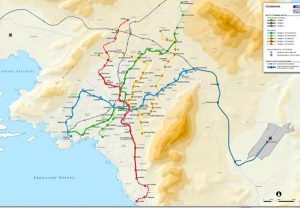
LINE 2 Red Line: It extends in a length of 17.5 km from Anthoupolis to Elliniko. It serves 20 stations. It is connected to LINE 1 at Attiki and Omonia stations, to LINE 3 at Syntagma station, and to the Suburban Railway and OSE at Larissa station.
LINE 3 Blue Line: It serves 27 stations and an additional 4, which it shares with the suburban rail. It is connected to LINE 1 at Monastiraki station and to LINE 2 at Syntagma station. The final extension to Piraeus included the stations of Maniatika, Piraeus and Municipal Theater (Dimotiko Theatro) and was completed on 10/10/2022. Passengers from the port of Piraeus can go straight to the airport of Athens within 1 hr and 5 minutes.
Facts about Athens
Area: 476 km²
Population: nearly 5,000,000 inhabitants
ATMs: Yes
Internet cafes: Yes
Highest peak: Lycabettus, 277m
Airport: Yes
Price Level: Depends on where you are
Metro: Yes
Trolley: Yes
Tram: yes
Tourist bus: line 400
Buses: Urban OASA, Suburban KTEL
International code: 0030
Area code: 210
Ambulance, First Aid: 199
Port Police: 4511311 (Piraeus)
Font: 100
Complaints (new GNTO service): 1572
Tourist police: 171 (urgent) 9239224
Hospitals, Clinics, Pharmacies: 1434
Trains: 145 (domestic), 147 (international)
Tourist information: 3310561
SOS Doctors: 1016
Athens Airport: 3530000
Taxis: 4115200 (Ermis) 5152899 (Ikaros)
Firefighters: 199
